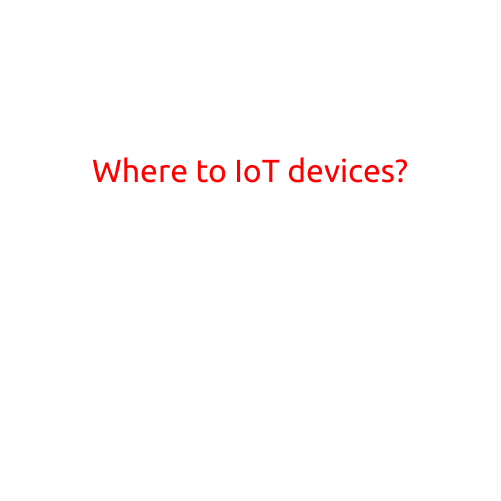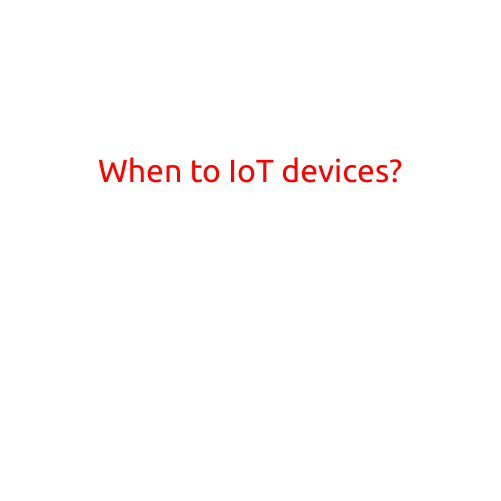
Where to Put Your IoT Devices? A Guide to Maximizing Their Effectiveness
The Internet of Things (IoT) has revolutionized the way we live and work, with devices ranging from wearables to home appliances to industrial equipment communicating with each other and the internet. However, with the rise of IoT devices, a common question arises: where to put them?
In this article, we’ll explore the different types of IoT devices, their purposes, and the best places to deploy them to maximize their effectiveness.
Types of IoT Devices and Their Purposes
Before we dive into where to put your IoT devices, let’s take a look at the different types of devices and their purposes:
- Smart Home Devices: These devices automate various tasks in your home, such as lighting, temperature, and security. Examples include smart thermostats, smart lights, and security cameras.
- Wearables: These devices track your physical activity, health metrics, and other personal data. Examples include fitness trackers, smartwatches, and heart rate monitors.
- Industrial IoT Devices: These devices monitor and control industrial equipment, such as machines, sensors, and actuators. Examples include industrial sensors, industrial automation systems, and remote monitoring devices.
- Environmental Monitoring Devices: These devices monitor and track environmental conditions, such as temperature, humidity, and air quality. Examples include weather stations, air quality monitors, and environmental sensors.
- Appliance-Control Devices: These devices control and monitor appliances in your home, such as refrigerators, washing machines, and air conditioners. Examples include smart refrigerators, smart washing machines, and smart thermostats.
Where to Put Your IoT Devices
Now that we’ve covered the different types of IoT devices, let’s explore where to put them to maximize their effectiveness:
- Smart Home Devices: Place smart home devices in areas where they can monitor and control the environment, such as:
- Living rooms (smart lights, TVs, and music systems)
- Kitchens (smart appliances, thermostats, and lighting)
- Bedrooms (smart thermostats, alarm systems, and sleep tracking devices)
- Wearables: Wearables are designed to be worn, so place them on your body, such as:
- On your wrist (smartwatches and fitness trackers)
- On your chest or arm (heart rate monitors and blood pressure monitors)
- On your ankle (activity trackers and fitness trackers)
- Industrial IoT Devices: Place industrial IoT devices near the equipment they monitor or control, such as:
- On machines (industrial sensors, actuators, and control systems)
- Near storage facilities (temperature and humidity sensors)
- In manufacturing areas (quality control systems and production monitoring devices)
- Environmental Monitoring Devices: Place environmental monitoring devices in areas where they can monitor and track environmental conditions, such as:
- Outdoor areas (weather stations, air quality monitors, and environmental sensors)
- Indoor areas (indoor air quality monitors and temperature/humidity sensors)
- Appliance-Control Devices: Place appliance-control devices near the appliances they control, such as:
- In the kitchen (smart refrigerators, smart washing machines, and smart air conditioners)
- In the living room (smart TVs and music systems)
- In the bedroom (smart thermostats and alarm systems)
Best Practices for Deploying IoT Devices
When deploying IoT devices, keep the following best practices in mind:
- Follow Manufacturer Guidelines: Follow the manufacturer’s guidelines for deploying and configuring IoT devices.
- Ensure Secure Connectivity: Ensure that IoT devices use secure connectivity options, such as encryption and secure protocols.
- Monitor and Maintain Devices: Regularly monitor and maintain IoT devices to ensure they are working properly and securely.
- Prioritize Data Management: Prioritize data management by storing data securely and transmitting it efficiently.
- Conduct Regular Audits: Conduct regular audits of IoT devices to ensure they are properly configured and functioning as intended.
In conclusion, the success of IoT devices depends on where they are placed. By understanding the different types of IoT devices and their purposes, you can deploy them in the most effective and efficient way possible. Remember to follow best practices for deploying, configuring, and maintaining IoT devices to maximize their effectiveness and security.





